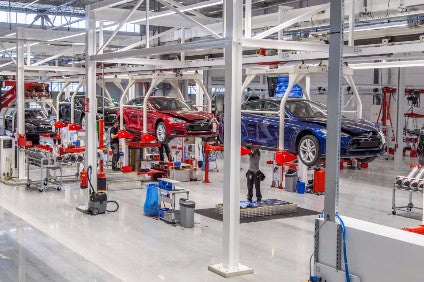Tesla is a fascinating company to watch. It’s a start-up (not exactly new though), is still losing money, but is making cars that serve a segment of the market set for major growth – battery electric vehicles. There is much to admire about Elon Musk’s vision and execution, but let’s not get too carried away.
Electric vehicles account for less than 1% of the global light vehicle market.
Electric vehicles are, to paraphrase English comedian Peter Kay, the future (‘Garlic bread, it’s the future, I’ve tasted it.’) And some of us are, indeed, getting a taste for EVs. But to keep that analogy going for a moment, many more people are still very much tied to the traditional bread that comes in plain white sliced or brown wholemeal form. Garlic bread occupies a niche part of the bread market. And electric vehicles account for less than 1% of the global light vehicle market. You heard that right, under 1%.
The picture is obviously going to change as more models come to market and battery performance (and charging infrastructure) improves, but it will still be a while before we’re all having garlic bread for breakfast toast (if you see what I mean). Plug-in hybrids and 48v mild hybrids are set to be in the vanguard of electrification. Gasoline engines are becoming much more efficient. Diesels may be losing share in the European car market, but cleaner diesels utilising the latest technologies are not going to be abandoned as OEMs pursue ever tighter mandated average CO2 limits. In addition, the hit to diesel in the car market will likely run out of steam as certain types of end-user see no reason to switch to an alternative. Light vehicle business users will continue to be drawn by lower fuel consumption on long-distance mileage as well as higher torque for load pulling. And, of course, road freight transportation will rely heavily on diesel powertrains for some time to come.
Tesla’s financial results are weighed down by heavy costs and slower than planned market sales following production delays.
Having touched them both a couple of years ago, Tesla’s market capitalisation (at $36bn) is now significantly under Ford’s ($42bn) and GM’s ($57bn). The relative standing of those three companies is something I keep an eye on. A reality check has perhaps finally dampened investor enthusiasm for Tesla stock. Tesla’s financial results are weighed down by heavy costs and slower than planned market sales following production delays. It’s not easy to make cars at volume when you are doing it for the first time, even if you hire many talented engineers from the established players. So, there’s the background market dampener of slow progress for EVs in general and then there are Tesla-specific issues at work.
Don’t get me wrong, I think what Tesla has achieved so far is phenomenal. From scratch it has done very well to get to where it is. Musk is driven by highly laudable motives and obviously deserves much credit for his imaginative PR stunts (and recently marrying the expertise of Space X with some very rich profile for Tesla). The ‘Gigafactory’ for EV batteries will be quite something if he keeps the giant plant busy. But there was probably a need for some of the fizz in the Tesla share price to come off of it (Musk himself said as much). There is risk. Tesla does not turn a profit and much now depends on the Model 3’s reception from customers, how it performs in reliability and satisfaction surveys. It’s understandable that Tesla is taking more time to get things right – but that also makes investors nervous about the potential for problems or hiccups in manufacturing.
Meanwhile, there is a widely held view that GM is well positioned for EV growth with its electric Bolt and able to invest more in areas such as electrification and autonomous vehicles now that it has jettisoned loss-making operations in troublesome regions of the world. By contrast, Ford – thus far, at least – is sticking with its strategy to be present in more markets around the world.
Ford could still be right to stick with being present in significant parts of the world that GM is leaving behind – Europe, Russia, India and South Africa. The pace at which the world moves to electric vehicles – in terms of significantly displacing mass-market ‘low-tech’ and much cheaper fossil fuel burning ICE fitted vehicles – is very far from certain. There will still be, potentially, big profits to be made from market geography factors (Russia’s vehicle market, for example, is now picking up and Ford has said it is close to breakeven there).
At this point, we’re not even sure how the power grid can cope with a major switchover from fossil fuels. Battery tech material supply questions will also loom larger as EV volumes grow.
A dose of realism is also advisable when considering AVs and carshare business models. We’ll still be driving cars ourselves for a while yet in many parts of the world. Owning a car – always ready to go and sitting outside the front door – works for many of us, even if we occasionally climb into an Uber or use another mode of transport. Major technological change is coming to transport, but the pace of potentially disruptive structural industrial change is still a huge unknown.
Investor sentiment towards automotive companies will continue to rise and fall. On that, at least, there is no doubt. Like other automotive OEMs, Tesla’s share price can go down, as well as up.







